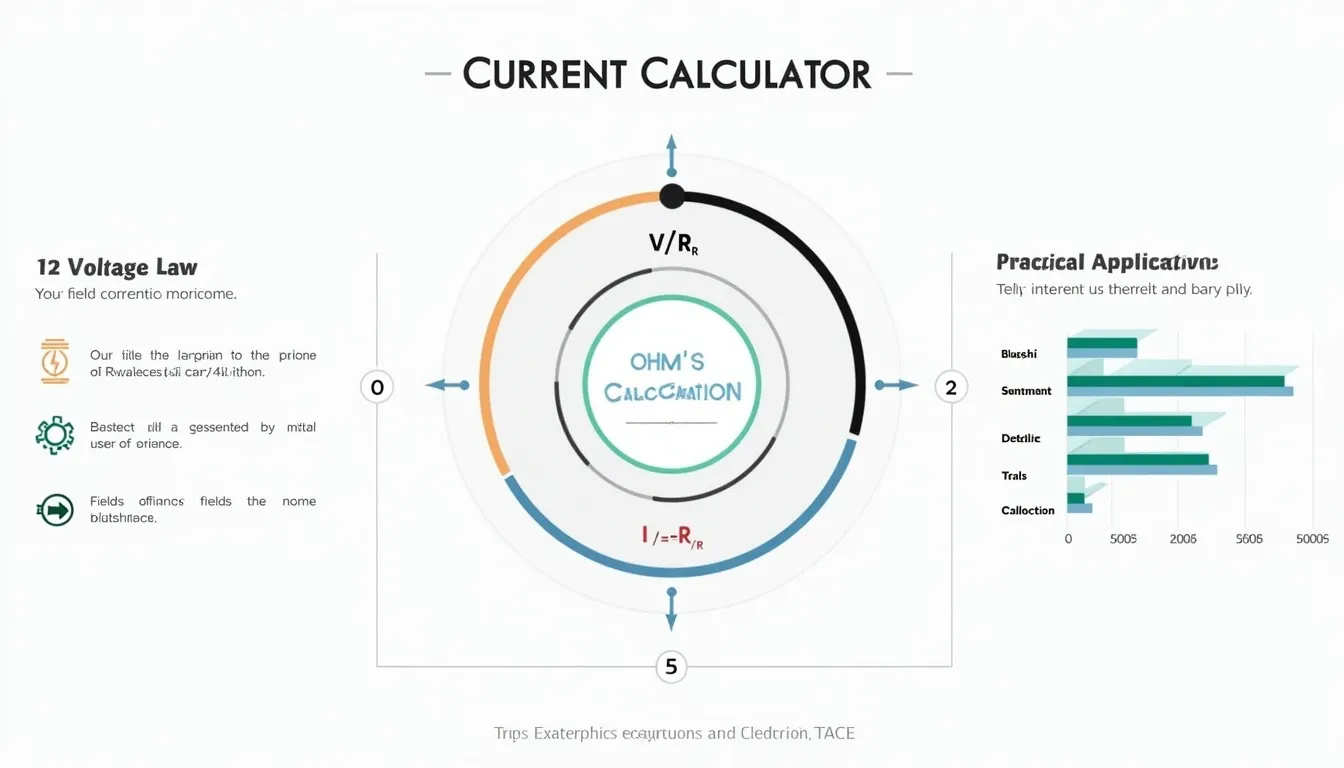Current Calculator
Is this tool helpful?
Welcome to our comprehensive guide on the Current Calculator, a powerful tool designed to streamline your electrical calculations and enhance your understanding of circuit analysis. Whether you’re a student, hobbyist, or professional electrician, this calculator will prove invaluable in your electrical endeavors.
How to Use the Current Calculator Effectively
Our Current Calculator is designed with user-friendliness in mind, ensuring that you can quickly and accurately determine the current in an electrical circuit. Here’s a step-by-step guide on how to use this tool effectively:
- Enter the Voltage: In the first input field, enter the voltage of your circuit in volts (V). This value represents the electrical potential difference driving the current through your circuit.
- Input the Resistance: In the second field, enter the resistance of your circuit in ohms (Ω). This value represents the opposition to the flow of electric current in your circuit.
- Calculate: Click the “Calculate Current” button to process your inputs.
- View Results: The calculator will display the calculated current in amperes (A) with two decimal places for precision.
It’s important to note that the calculator only accepts positive values for both voltage and resistance. If you attempt to enter a negative number, you’ll receive an alert prompting you to enter a positive value instead.
Understanding the Current Calculator: Definition, Purpose, and Benefits
The Current Calculator is a digital tool that computes the electric current flowing through a circuit based on the principles of Ohm’s Law. This fundamental law of electrical circuits states that the current flowing through a conductor is directly proportional to the voltage across the conductor and inversely proportional to its resistance.
The primary purpose of this calculator is to simplify the process of determining current in electrical circuits, eliminating the need for manual calculations and reducing the risk of errors. By automating this calculation, the tool saves time and enhances accuracy, making it an indispensable asset for anyone working with electrical systems.
The Mathematical Foundation: Ohm’s Law
At the heart of our Current Calculator lies Ohm’s Law, a cornerstone principle in electrical engineering. This law is expressed mathematically as:
$$I = \frac{V}{R}$$Where:
- I is the current in amperes (A)
- V is the voltage in volts (V)
- R is the resistance in ohms (Ω)
This elegant equation forms the basis of our calculator’s functionality, allowing for quick and accurate current calculations in various electrical scenarios.
Benefits of Using the Current Calculator
Incorporating the Current Calculator into your electrical work or studies offers numerous advantages:
- Time-Saving: Eliminate manual calculations and get instant results, allowing you to focus on other aspects of your project or study.
- Error Reduction: Minimize the risk of calculation errors that can occur with manual computations, especially when dealing with complex circuits or multiple calculations.
- Precision: Our calculator provides results to two decimal places, ensuring a high level of accuracy in your current determinations.
- Accessibility: Access the calculator anytime, anywhere with an internet connection, making it a convenient tool for field work or remote learning.
- Educational Value: Reinforce your understanding of Ohm’s Law and electrical principles through practical application.
- Versatility: Use the calculator for a wide range of applications, from simple household circuits to complex industrial systems.
- Consistency: Ensure uniform calculations across teams or classrooms, promoting standardized results and easier collaboration.
Addressing User Needs and Solving Specific Problems
The Current Calculator addresses several key needs and solves specific problems encountered in electrical work and study:
1. Quick Circuit Analysis
For electricians and engineers working on-site, the ability to quickly analyze circuit characteristics is crucial. Our calculator allows for instant current calculations, enabling faster decision-making and troubleshooting in the field.
2. Educational Support
Students learning about electrical principles can use this tool to verify their manual calculations, reinforcing their understanding of Ohm’s Law and circuit behavior. It serves as a valuable check for homework and exam preparation.
3. Design Optimization
When designing new electrical systems, engineers can use the calculator to quickly iterate through different voltage and resistance values, optimizing current flow for efficiency and safety.
4. Safety Compliance
By accurately determining current levels, the calculator helps ensure that circuits are designed and operated within safe parameters, reducing the risk of overloads and electrical hazards.
5. Energy Efficiency Analysis
Understanding current flow is crucial for assessing energy consumption. The calculator aids in identifying high-current areas in a system, allowing for targeted efficiency improvements.
6. Troubleshooting Aid
When diagnosing electrical issues, knowing the expected current in a circuit is essential. This calculator provides a quick reference point for comparing actual measurements to theoretical values.
Practical Applications and Use Cases
The Current Calculator finds applications across various fields and scenarios. Here are some practical examples:
1. Home Wiring Projects
A homeowner planning to install a new light fixture needs to ensure the wiring can handle the current. By entering the household voltage (e.g., 120V) and the fixture’s resistance, they can determine if the current is within safe limits for the existing wiring.
2. Automotive Electrical Systems
An auto mechanic troubleshooting a car’s electrical system can use the calculator to check if the current draw of a component matches the specifications. For instance, if a 12V battery is connected to a 4Ω headlight, the expected current would be 3A. Any significant deviation could indicate a problem.
3. Solar Panel Installation
When designing a solar power system, engineers need to calculate the current output of solar panels under various conditions. By inputting the panel’s voltage output and internal resistance, they can estimate the current production and size the inverters and wiring accordingly.
4. Electronics Prototyping
A hobbyist building a custom LED circuit can use the calculator to determine the appropriate resistor value. If they have a 3V power source and want to limit the current to 20mA for an LED, they can experiment with different resistance values to achieve the desired current.
5. Industrial Motor Control
In an industrial setting, knowing the current draw of large motors is crucial for proper circuit breaker sizing. An electrician can use the calculator to verify if the existing protection is adequate for new equipment installations.
6. Battery Life Estimation
When designing battery-powered devices, engineers can use the calculator to estimate current draw and, consequently, battery life. For example, if a 9V battery powers a circuit with 1kΩ resistance, the current draw would be 9mA, helping to predict how long the battery will last.
Frequently Asked Questions (FAQ)
Q1: What is the Current Calculator used for?
A1: The Current Calculator is used to determine the electric current flowing through a circuit based on the voltage and resistance values. It’s a valuable tool for electrical engineers, students, and hobbyists working with electrical circuits.
Q2: How accurate is the Current Calculator?
A2: Our Current Calculator provides results to two decimal places, offering a high degree of accuracy for most practical applications. However, for extremely precise scientific or industrial applications, you may need to use more specialized equipment.
Q3: Can I use the calculator for AC circuits?
A3: This calculator is primarily designed for DC circuits. For AC circuits, additional factors like frequency and reactance need to be considered, which are not accounted for in this simple Ohm’s Law calculator.
Q4: What should I do if I get a “division by zero” error?
A4: This error occurs if you enter zero for the resistance value. In practical terms, a resistance of zero would represent a perfect conductor, which doesn’t exist in real-world applications. Always ensure you enter a positive, non-zero value for resistance.
Q5: Why can’t I enter negative values for voltage or resistance?
A5: The calculator is designed to work with positive values to reflect real-world electrical scenarios. While negative voltages can exist in certain contexts, they typically require more complex analysis beyond the scope of this simple calculator.
Q6: How does this calculator relate to power calculations?
A6: While this calculator doesn’t directly compute power, the current it calculates can be used to determine power. Power (P) in watts is equal to voltage (V) multiplied by current (I), or P = V * I.
Q7: Can this calculator be used for parallel circuits?
A7: This calculator is designed for simple series circuits. For parallel circuits, you would need to calculate the equivalent resistance first, which involves a different set of calculations.
Q8: Is there a maximum value for voltage or resistance that I can enter?
A8: The calculator can handle a wide range of values, but extremely large numbers may lead to rounding errors. For most practical applications, you shouldn’t encounter any issues with the value ranges.
Q9: How does temperature affect the calculations?
A9: This calculator doesn’t account for temperature effects on resistance. In real-world scenarios, resistance can change with temperature, which could affect the current. For high-precision work, consider these temperature effects separately.
Q10: Can I trust the results of this calculator for critical applications?
A10: While our Current Calculator is designed to be accurate and reliable, we cannot guarantee that the results are always correct, complete, or reliable for every situation. Our content and tools might have mistakes, biases, or inconsistencies. For critical applications, always verify results with multiple methods and consult with qualified professionals.
Conclusion: Empowering Your Electrical Endeavors
The Current Calculator stands as a powerful ally in your electrical projects and studies, offering a blend of simplicity, accuracy, and efficiency. By leveraging the fundamental principles of Ohm’s Law, this tool empowers you to:
- Quickly analyze electrical circuits
- Enhance your understanding of current, voltage, and resistance relationships
- Improve safety in electrical designs and installations
- Optimize energy efficiency in various applications
- Save time and reduce errors in electrical calculations
Whether you’re a student grappling with electrical theory, a DIY enthusiast working on home projects, or a professional engineer designing complex systems, the Current Calculator is an invaluable resource that simplifies your work and enhances your productivity.
We encourage you to make the most of this tool in your electrical endeavors. Remember, while it’s a powerful aid, it’s always important to apply your knowledge, follow safety guidelines, and consult with experts when dealing with complex or critical electrical systems.
Start using the Current Calculator today and experience the difference it can make in your electrical calculations and understanding. Embrace the power of precision and efficiency in your electrical work!
Important Disclaimer
The calculations, results, and content provided by our tools are not guaranteed to be accurate, complete, or reliable. Users are responsible for verifying and interpreting the results. Our content and tools may contain errors, biases, or inconsistencies. We reserve the right to save inputs and outputs from our tools for the purposes of error debugging, bias identification, and performance improvement. External companies providing AI models used in our tools may also save and process data in accordance with their own policies. By using our tools, you consent to this data collection and processing. We reserve the right to limit the usage of our tools based on current usability factors. By using our tools, you acknowledge that you have read, understood, and agreed to this disclaimer. You accept the inherent risks and limitations associated with the use of our tools and services.







